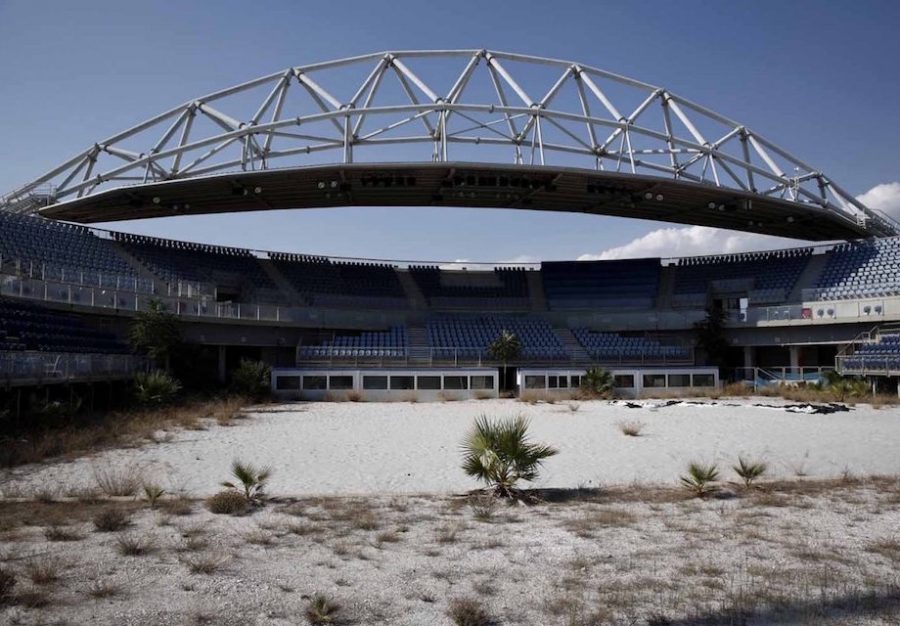The aftermath of the games: Olympic and World Cup controversies
January 15, 2019
We all enjoy when a large sporting event rolls around.
The amazing moments when we are given the chance to witness the colorful performances put on before and after the games begin, the chance to root for our favorite team, athletes, or our home country, and the glorious celebration of those who have achieved the impossible.
Nothing embodies these feelings more than the Olympics and the World Cup.
They are the pinnacle of sporting events, when it comes to the excitement they emit. However, in their wake they seem to leave the opposite of what they were meant to bring.
Stadiums abandoned, economies crippled and citizens left to wonder whether it was really worth all the effort. This has become a large problem world wide, with more and more countries jumping at the chance to host these events in hopes of increasing tourism and gaining some recognition.
Unfortunately, for countries that are not nearly as economically stable as say the United States or China, this becomes the first problem they must face in the aftermath.
For example, the 2004 Summer Games, which took place in Athens, Greece, put the country 14.5 billion dollars in debt, at a time when they were already struggling economically.
The previous Summer Olympics to that, which were held in Sydney, Australia, in the year 2000, was so expensive, it was triple the estimated budget, leaving the country in a debt of almost 6.5 billion dollars. What’s worse is that in a drastic attempt to pay off that debt, the public was forced to pay about a third of it, which is almost around 2.2 billion dollars.
The interesting thing is key to take in mind when discussing this subject is that, while there are many countries that can pitfall into an economic crisis in the aftermath of these games, there are countries that can indeed profit off of the popularity that the Olympics or World Cup bring.
The greatest example of this being the 1992 Games in Barcelona, Spain, which also happened to be the last time both the Summer and Winter Olympics were to happen at the same time together. In the aftermath of the games, the newfound fame helped to grow the city to what it is now, from its previously struggling incarnation. This is a rare case, however, as the only other cities that find profit are the ones that are heavily stable when it comes to their economy and are already physically prepared to host. This means they already possess the needs to host the games, such as large stadiums for each and every sport, which can be easily modified with little to no cost if need be, leaving both the country and city in perfect economic health. This is the same case when it comes to the World Cup, with some countries being left unscathed, while others like South Africa and Brazil both suffer a devastating blow to their economies, leaving them in debt, and with something more eerie.
The most eerie thing that remains after these events end is not the economic crisis many experience, but the abandoned facilities that are left behind as an unsettling reminder of how it once was for such a short time. These places range from smaller, swimming pools and gymnastic arenas, to immensely large stadiums meant for soccer as well as track and field events. All meant to seat thousands of spectators. Even hotels that were specifically built for visitors of the games are left abandoned. All meant to host thousands of visitors. These all now have one thing in common, with the games now having been over for years: they are unused, rotting and off limits.
Stadiums like the Hellinikon Baseball Facility in Athens which shows signs of rust and no repair, with a field reminiscent of a desert. Then there’s Brazil’s 300 million dollar stadium, Arena Da Amazonia, which took 4 years to construct and cost 3 workers their lives. In the end the Stadium was only used for 4 matches during the 2014 World Cup, as well as a few matches during the 2016 Summer Olympics. Although the stadium can seat around 40,000 people, for local matches the stadium only sees around 1,000 actual visitors show up. This is only the tip of the iceberg when it comes to these abandoned stadiums. Considering just how many Olympics have been held, there are most likely a much larger amount of abandoned stadiums than originally thought, maybe hundreds, not to mention the facilities specifically built for the events. Arenas that were meant to be filled with the cheers of ecstatic fans, now sit in silence.
Though the cost of billions of dollars is what comes to mind when discussing the stadiums, the construction of these buildings often comes at the cost of the public and citizens of the host cities. In many different ways, the populous of a city has been affected negatively by mainly the Olympics. As previously mentioned, people involved in the construction have lost their lives, and have even had to pay for a part of the fees some governments owe.
However, in some cases people have even been forced to relocate.
In Beijing, China, families were even forced out of their homes in order for Olympic venues to be constructed. It’s an unfortunate price that people must take in order for there to be entertainment and competition in the sports world.
In the end, this problem is becoming more well-known and discussed more among various media outlets. However, many larger and more popular channels are most likely to dismiss this since both the World Cup and Olympics are beloved by many and give the media a field day.
This sadly, may be the reason so many are too blind to see the suffering and struggles of those who are affected. All is caused through one dark and driving force within the organizations that are responsible for these events, and though corruption among the organizers of the World Cup, FIFA, has come out in the recent years, we still have yet to see whether that will have an impact on how the next World Cup plays out.
Now with the next World Cup to be hosted in Qatar, a country that has been under fire for the ways it has been treating its responsibilities to the tournament and is believed to be severely under equipped for the task; and with the next Summer Olympics to be held in Tokyo, Japan, a city who is also being questioned for its timing for the games which are taking place around a very humid and high temperature time which could have tremendous impacts on the health of the athletes; we can only wait and see whether it will all be worth the wait.
Sources:
https://www.npr.org/sections/pictureshow/2013/06/21/194199546/what-happens-to-an-olympic-city-after-the-olympics
https://www.manning-napier.com/insights/blogs/markets-and-economy/the-economic-impact-of-the-olympics
https://www.nytimes.com/2003/12/24/news/what-did-olympics-bring-sydney.html
https://www.cbsnews.com/pictures/olympic-venues-that-were-abandoned/21/
https://www.youtube.com/watch?v=AOHP0pH0yMA
https://thearabweekly.com/2022-world-cup-disaster-qatar-whether-it-hosts-it-or-not
Links to pictures of abandoned stadiums:
https://www.cbsnews.com/pictures/olympic-venues-that-were-abandoned/






